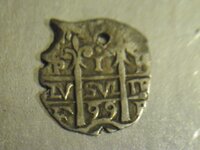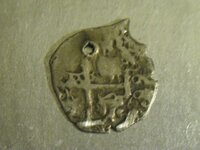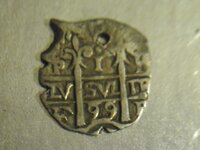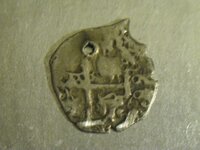Tom_in_CA
Gold Member
- Mar 23, 2007
- 13,804
- 10,335
- 🥇 Banner finds
- 2
- Detector(s) used
- Explorer II, Compass 77b, Tesoro shadow X2
A buddy of mine is a nugget hunter from the sierra foothills area of CA. And as you know, sometimes nugget hunters come accross other un-intended items, like coins or whatever  This particular nugget producing region he was hunting, isn't far from where there had been gold rush era (late 1840s to early 1850s-ish?) camptowns. Go figure, the boom-towns sprung up in regions where, still to this day, would be regions where nuggets would be, eh? Nugget guys work the tailing piles of yesteryear, for example, where occasional old industrial just (nails, iron, etc..) got mixed in.
This particular nugget producing region he was hunting, isn't far from where there had been gold rush era (late 1840s to early 1850s-ish?) camptowns. Go figure, the boom-towns sprung up in regions where, still to this day, would be regions where nuggets would be, eh? Nugget guys work the tailing piles of yesteryear, for example, where occasional old industrial just (nails, iron, etc..) got mixed in.
At this particular hunt site area in Placer county, he and his buddies had "incidentally" found a few coins over the years. Like an 1840's seated quarter, a $5 gold (I dunno the year of that one) and some Chinese cache coins. Well imagine my friend's surprise when this cob turned up. Can anyone venture a date or ID? I think I see the "17...." but can't make out more digits.
I've heard of a few cobs being found in CA, but it would be very hard (theoretically) to find them here. Because go figure: aside from the explorer era, the first permanent European toe-hold was not till 1769 (San Diego) and into the 1770s. And even then-so, was only along the coastal and coastal valleys, supposedly. And even then-so, it wasn't till nearly 1800, that the entire non-indian population numbered more than a few thousand in the entire state! (primarily around the missions, pueblos, presidios, and related sites). The interior central valley, and sierra foothills area is, as far as all accounts go, was un-explorered and un-charted. Heck, some maps still thought CA was even still an island up till then!
So we are guessing this cob must have circulated up till the gold rush era. That makes this very unusual, because as you know, cobs had given way to milled coins, by as early as the 1730s. A few mints and countries still did cob style till the 1760s perhaps, before transitioning to cobs? So you can see that a cob lost in, say the earlier part of the gold rush of the late 1840s, would have required nearly 80-ish years of circulation!
Spanish coins did circulate here in CA in the early gold rush times (as we had, up till then, been a Spanish and Mexican settlement). Milled Reales are not uncommon to find here And do turn up in sites that date to as late as the 1850s/60s here. as there was initially a "coin shortage", since the SF mint didn't get started till the early 1850s. But typically their dates are like the 1820s to 1840s or whatever when you're talking sites at the tail end of the period when reales circulated here. While nothing would have prevented cobs from being circulated with reales too, it is quite a stretch!
The other cobs I've heard of being found were near Monterey, San Diego, and another near San Francisco, etc... Places that had European influenced toe-holds by the 1770s, for example. I've found nearly 50 reales in my time hunting CA, dating back to the 1750s, but have never found a Cob here.
I invite comments on the ID of this, the value, and any comments on the provenance. thanx!


 This particular nugget producing region he was hunting, isn't far from where there had been gold rush era (late 1840s to early 1850s-ish?) camptowns. Go figure, the boom-towns sprung up in regions where, still to this day, would be regions where nuggets would be, eh? Nugget guys work the tailing piles of yesteryear, for example, where occasional old industrial just (nails, iron, etc..) got mixed in.
This particular nugget producing region he was hunting, isn't far from where there had been gold rush era (late 1840s to early 1850s-ish?) camptowns. Go figure, the boom-towns sprung up in regions where, still to this day, would be regions where nuggets would be, eh? Nugget guys work the tailing piles of yesteryear, for example, where occasional old industrial just (nails, iron, etc..) got mixed in.At this particular hunt site area in Placer county, he and his buddies had "incidentally" found a few coins over the years. Like an 1840's seated quarter, a $5 gold (I dunno the year of that one) and some Chinese cache coins. Well imagine my friend's surprise when this cob turned up. Can anyone venture a date or ID? I think I see the "17...." but can't make out more digits.
I've heard of a few cobs being found in CA, but it would be very hard (theoretically) to find them here. Because go figure: aside from the explorer era, the first permanent European toe-hold was not till 1769 (San Diego) and into the 1770s. And even then-so, was only along the coastal and coastal valleys, supposedly. And even then-so, it wasn't till nearly 1800, that the entire non-indian population numbered more than a few thousand in the entire state! (primarily around the missions, pueblos, presidios, and related sites). The interior central valley, and sierra foothills area is, as far as all accounts go, was un-explorered and un-charted. Heck, some maps still thought CA was even still an island up till then!

So we are guessing this cob must have circulated up till the gold rush era. That makes this very unusual, because as you know, cobs had given way to milled coins, by as early as the 1730s. A few mints and countries still did cob style till the 1760s perhaps, before transitioning to cobs? So you can see that a cob lost in, say the earlier part of the gold rush of the late 1840s, would have required nearly 80-ish years of circulation!
Spanish coins did circulate here in CA in the early gold rush times (as we had, up till then, been a Spanish and Mexican settlement). Milled Reales are not uncommon to find here And do turn up in sites that date to as late as the 1850s/60s here. as there was initially a "coin shortage", since the SF mint didn't get started till the early 1850s. But typically their dates are like the 1820s to 1840s or whatever when you're talking sites at the tail end of the period when reales circulated here. While nothing would have prevented cobs from being circulated with reales too, it is quite a stretch!
The other cobs I've heard of being found were near Monterey, San Diego, and another near San Francisco, etc... Places that had European influenced toe-holds by the 1770s, for example. I've found nearly 50 reales in my time hunting CA, dating back to the 1750s, but have never found a Cob here.
I invite comments on the ID of this, the value, and any comments on the provenance. thanx!





 It almost seems there was a strict cut-off date they stopped circulation, but I don't think that was the case, because by all accounts silver was silver here for a very long time.
It almost seems there was a strict cut-off date they stopped circulation, but I don't think that was the case, because by all accounts silver was silver here for a very long time. I only have two.
I only have two.




